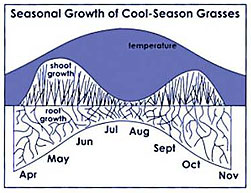How Grass Grows

Courtesy of Bob Mugaas
University of Minnesota Department of Horticulture
Before describing the steps toward making the transition to YardScaping practices and to help you understand the prudent and timely use of lawn care products, here is a brief description of the growth cycle of lawn grasses. The turf grasses grown in our climate are perennials known as cool-season grasses. Turf grasses adapted to southern states are perennials known as warm-season grasses. Cool-season grasses have growth peaks in both the spring and fall, while warm-season grasses have their peak growth during summer months.
During the short days and cool temperatures of late fall and early spring, mature shoots of cool-season grasses cease to produce new leaves; they "switch" over to shoots that produce flower stems during the long days and warm temperatures of late May through June. So, most of the growth that occurs during this period is the production of flower stems, which often goes unnoticed due to regular mowing.
Once grass shoots complete their flowering cycle, both the shoots and their roots die. Since these dead shoots are continually replaced by new ones and by those not mature enough to flower, there is little detectable difference in the lawn other than a somewhat thinner appearance by the end of June and early July. Natural rejuvenation of the lawn begins again in mid-July or early August, and the process starts over.
Roots of cool-season grasses grow during the cool weather of spring and fall. Root growth begins and peaks before peak shoot growth in the spring. Though there is some shoot growth during summer months (provided that grass plants are not in summer dormancy), root growth at this time is very slow. Their growth activity begins again in fall.
Since maximum root growth and maximum shoot growth do not occur at the same time (and are even somewhat antagonistic to each other), it is important to adjust your management practices to optimize growth of either roots or shoots. This establishes a healthy turf, which is especially important as you consider lower inputs.